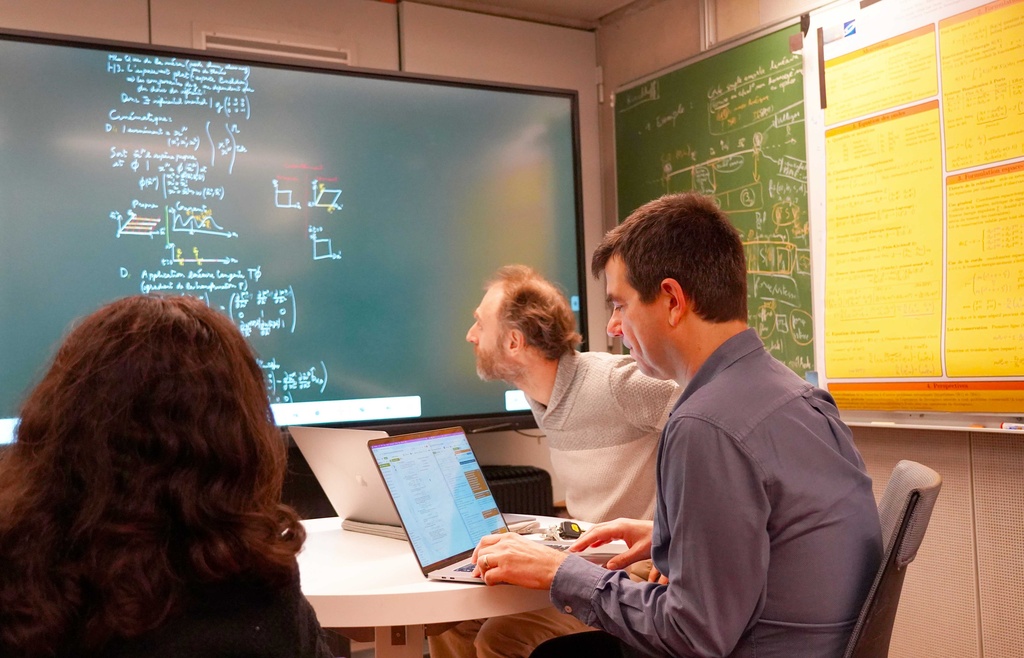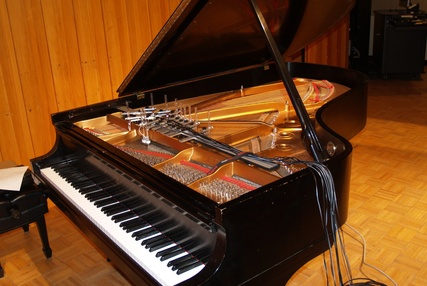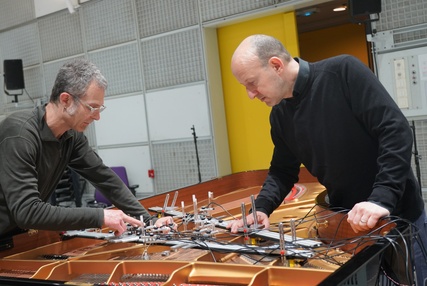Directeur de recherche au sein de l’équipe « Systèmes et signaux sonores : audio/acoustique, instruments » (S3AM), Thomas Hélie évoque pour nous la manière dont les recherches de Per Bloland et Richard Causton, sur le piano électromagnétiquement préparé, s’inscrivent dans les activités et l’histoire de l’équipe, créée en 2017.
Qu’est-ce qui vous a séduit dans le projet porté par Per Bloland et Richard Causton ?
D’abord, des membres de l’équipe, à l’instar de Joël Bensoam, avaient déjà été en contact avec eux. La confiance mutuelle était donc déjà établie. Ensuite, ils n’en étaient pas à leurs débuts : Per travaille sur le concept de piano électromagnétiquement préparé depuis une vingtaine d’années – notamment en Angleterre avec Andrew McPherson. Per y participe depuis 5 ans. C’est un travail que nous connaissions déjà, et que nous trouvions intéressant en termes de résultat sonore et, plus largement, d’applications.Cependant, jusque-là, ils n’avaient pas exploré le contrôle actif. C’est-à-dire qu’ils se contentaient d’envoyer des vibrations dans la corde, mais ne les mesuraient pas et n’ajustaient pas l’action en fonction de la mesure obtenue. Per Bloland et Richard Causton sont justement venus vers nous dans ce but.D’autre part, notre équipe n’avait pas encore travaillé spécifiquement sur le piano. Nous avons beaucoup d’expérience de contrôle actif sur les instruments à vent, sur les tables d’harmonie (et donc, par extension, sur le piano, mais qui n’était en l’occurrence qu’un cas particulier parmi d’autres), sur les cordes frottées (mais l’actionneur agissait alors sur la table d’harmonie ou à proximité du chevalet, pas sur la corde elle-même). Dans ce projet-là, nous travaillons directement sur la captation et l’actionnement de la corde elle-même.
Nous ne pouvons donc pas avoir recours aux mêmes transducteurs que d’habitude : l’actionneur électromagnétique utilisé ici nous offre la perspective d’un nouvel instrument à explorer, sur lequel aucun contrôle actif n’a jamais été tenté – du moins pas récemment.

Thomas Hélie à l'Ircam © Ircam-Centre Pompidou
L’Ircam a-t-il une expérience dans ce domaine très précis ?
Si l’on remonte assez loin dans l’histoire de l’institut, des lois de contrôle des vibrations par actionneur électromagnétique ont été établies il y a longtemps, mais avec des technologies assez anciennes et analogiques. Nous avons aujourd’hui les moyens de revisiter le sujet avec des technologies plus récentes, et grâce à notre plus ample connaissance des algorithmes de contrôle.
Comment cette résidence en recherche artistique s’inscrit-elle dans les recherches de l’équipe S3AM ?
On ne part pas de zéro, on adapte l’existant. Par exemple, pour l’actionneur électromagnétique lui-même. On connaît bien le comportement d’une bobine électromagnétique dans un haut-parleur. Les sources de distorsions dans le haut-parleur et dans le couplage électromagnétique sont très étudiées, même s’il reste beaucoup à apprendre et à modéliser. Mais l’actionneur qui nous intéresse n’est pas une bobine en mouvement comme dans le haut-parleur. Ici, la bobine ne bouge pas, elle agit comme un électroaimant qui anime la corde. Modéliser la chose est d’autant moins simple que le champ magnétique produit n’est ni homogène ni linéaire.
Deuxième point : l’excitation elle-même, et la manière dont elle réagit au signal électrique (qui sert de relais entre l’ordinateur, et la conception du son, et la production du son) : la relation entre l’excitation électrique et le champ magnétique produit n’est pas linéaire, et il faut donc la comprendre elle aussi pour pouvoir la modéliser et contrôler au mieux le système et le résultat sonore.
Du point de vue du contrôle actif, ce genre d’actionneur électromagnétique a déjà fait l’objet de recherches poussées, mais elles visaient plutôt à la stabilisation du champ magnétique, en vue de faire léviter des objets, comme le Maglev ou train à sustentation magnétique. Rien n’avait été fait concernant le contrôle des vibrations à des fins musicales. Or, comme souvent, la modélisation et les lois de contrôles sont très liées aux objectifs qu’on se fixe. Pour produire des effets sonores précis (comme changer des fréquences ou modifier un spectre), les lois de contrôles sont d’une architecture bien différente que celles destinées à faire léviter un train. En l’occurrence, les algorithmes que nous utilisons sont proches de ceux que nous avons mis au point pour le xylophone ou les drums. Ainsi, le dispositif au cœur des recherches de Per et Richard croise de nombreux sujets qui occupent l’équipe, ce qui nous permet de développer nos idées dans plusieurs directions.
S’agissant du matériel, quels sont les champs d’exploration ?
Les actionneurs peuvent sans doute être améliorés, voire repensés, mais nous ne nous en occupons pas pour l’instant. Per et Richard s’y sont intéressés et la question se reposera sans doute, mais ils se concentrent pour l’heure sur les amplis qui alimentent chaque électroaimant, afin d’avoir des plages d’amplitudes adaptées à la performance musicale dans une grande variété de lieux. Car l’un des grands goulots d’étranglement aujourd’hui, c’est la puissance, surtout dans le registre grave, ou si l’on veut actionner les cordes en dehors de leurs fréquences propres et plus encore si l’on veut agir au cours de l’attaque.
Qu’attendez-vous de cette résidence pour l’équipe S3AM ?
D’un point de vue scientifique, nous en attendons une preuve de concept. Nous voulons montrer que le dispositif fonctionne sur les cordes d’un piano et qu’il est fiable.
Ensuite, potentiellement, élargir l’application des résultats obtenus à d’autres instruments. Mais, là encore, un enjeu important est la puissance déployée.
Enfin, du point de vue artistique, les sons obtenus sont absolument inouïs et fascinants. Grâce à la diffusion via la table d’harmonie du piano, ils sont également très enveloppants – rien à voir avec un ensemble de haut-parleurs. Richard compose actuellement une pièce qui devrait être créée en mars 2024, et Per et Richard travaillent chacun à de nouvelles compositions où ces sons incroyables pourront s’épanouir.
![]()
Propos recueillis par Jérémie Szpirglas




